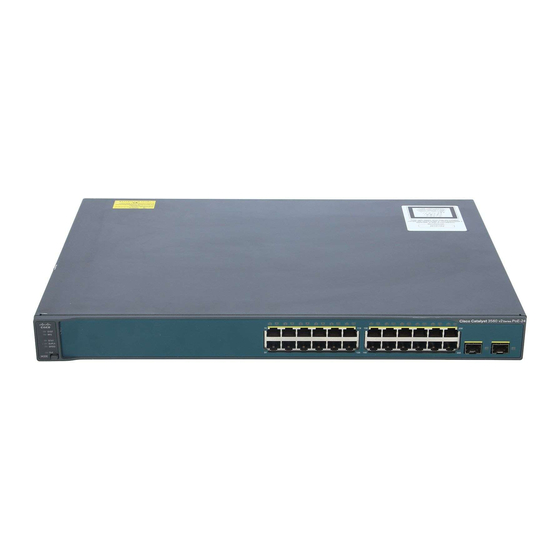Cisco 3560V2 - Catalyst 48 10/100 Poe Lembar data - Halaman 7
Jelajahi secara online atau unduh pdf Lembar data untuk Beralih Cisco 3560V2 - Catalyst 48 10/100 Poe. Cisco 3560V2 - Catalyst 48 10/100 Poe 20 halaman. Cisco catalyst 3560v2-24ps: specifications

Availability and Scalability
The Cisco Catalyst 3560 v2 Series is equipped with a robust set of features that allow for network scalability and
higher availability through IP routing as well as a complete suite of Spanning Tree Protocol enhancements aimed to
maximize availability in a Layer 2 network.
Enhancements to the standard Spanning Tree Protocol, such as Per-VLAN Spanning Tree Plus (PVST+), Uplink
Fast, and PortFast, maximize network uptime. PVST+ allows for Layer 2 load sharing on redundant links to efficiently
use the extra capacity inherent in a redundant design. Uplink Fast, PortFast, and BackboneFast all greatly reduce
the standard 30- to 60-second Spanning Tree Protocol convergence time. Loop guard and bridge-protocol-data-unit
(BPDU) guard provide Spanning Tree Protocol loop avoidance. Superior redundancy features include:
Cisco Uplink Fast and BackboneFast technologies help ensure quick failover recovery, enhancing overall
●
network stability and reliability.
IEEE 802.1w Rapid Spanning Tree Protocol (RSTP) provides rapid spanning-tree convergence independent
●
of spanning-tree timers and the benefit of distributed processing.
Per-VLAN Rapid Spanning Tree Plus (PVRST+) allows rapid spanning-tree reconvergence on a per-VLAN
●
spanning-tree basis, without requiring the implementation of spanning-tree instances.
Cisco Hot Standby Router Protocol (HSRP) is supported to create redundant, fail-safe routing topologies.
●
FlexLink allows a fast failover for redundant links in a Layer 2 network. FlexLink offers a faster convergence
●
than Spanning Tree Protocol and also eliminates the need for Spanning Tree Protocol.
FlexLink Load Balancing allows both the primary and the backup links to carry traffic for different sets of
●
VLANs. If an interface goes down, the peer interface will carry all the traffic for all VLANs.
Command-switch redundancy enabled in Cisco Network Assistant software allows designation of a backup
●
command switch that takes over cluster-management functions if the primary command switch fails.
Unidirectional Link Detection Protocol (UDLD) and Aggressive UDLD allow unidirectional links to be detected
●
and disabled to avoid problems such as spanning-tree loops.
Switch port autorecovery (errdisable) automatically attempts to reenable a link that is disabled because of a
●
network error.
Cisco RPS 2300 support provides superior internal power-source redundancy, resulting in improved fault
●
tolerance and network uptime.
Equal cost routing (ECR) provides load balancing and redundancy.
●
Bandwidth aggregation up to 8 Gbps through Cisco Gigabit EtherChannel technology and up to 800 Mbps
●
through Cisco Fast EtherChannel technology enhances fault tolerance and offers higher-speed aggregated
bandwidth between switches and to routers and individual servers.
High-Performance IP Routing
The Cisco Catalyst 3560 v2 series switches deliver high-performance, hardware-based IP routing. The Cisco
Express Forwarding-based routing architecture allows for maximum scalability and performance.
Implementing routed uplinks to the core improves network availability by enabling faster failover protection and
simplifying the Spanning Tree Protocol algorithm by terminating all Spanning Tree Protocol instances at the
aggregator switch. If one of the uplinks fails, quicker failover to the redundant uplink can be achieved with a scalable
routing protocol such as Open Shortest Path First (OSPF) or Enhanced Interior Gateway Routing Protocol (EIGRP)
rather than relying on standard Spanning Tree Protocol convergence. Redirection of a packet after a link failure
using a routing protocol results in faster failover than a solution that uses Layer 2 spanning-tree enhancements.
Additionally, routed uplinks allow better bandwidth use by implementing equal cost routing (ECR) on the uplinks to
© 2009 Cisco Systems, Inc. All rights reserved. This document is Cisco Public Information.
Data Sheet
Page 7 of 20
